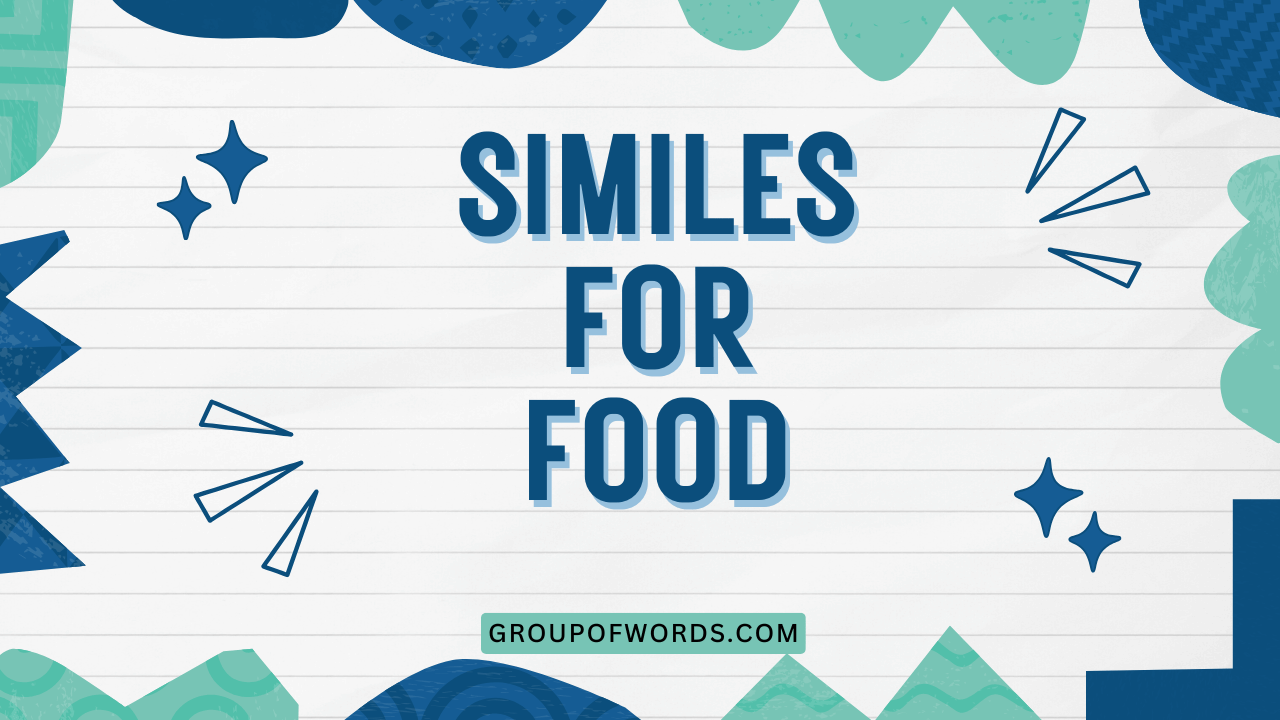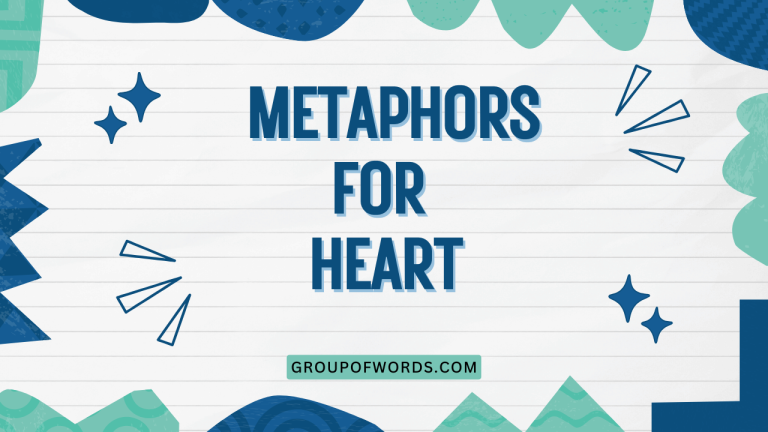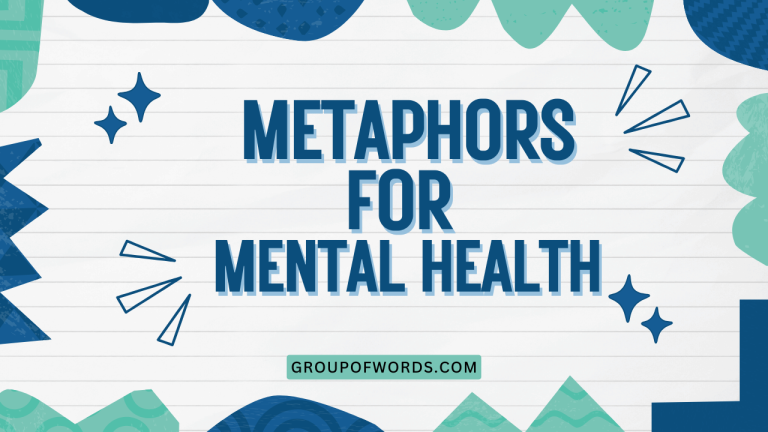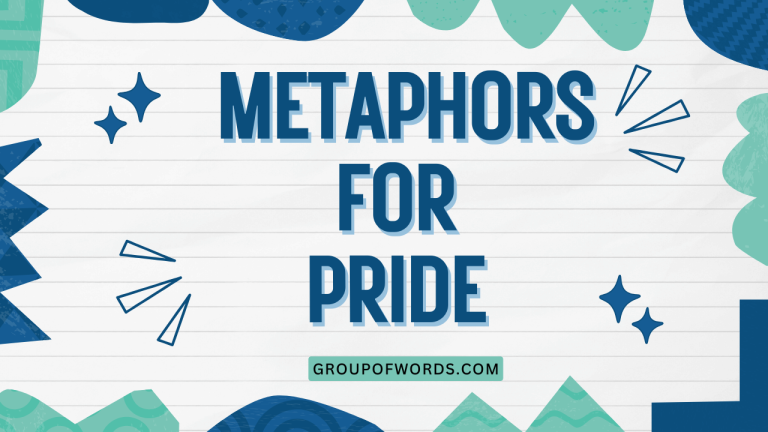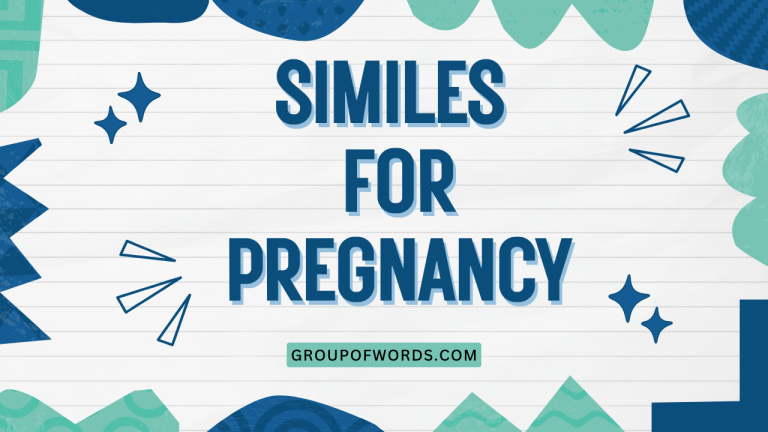Similes for Food: A Delicious Dive into Figurative Language
Similes are powerful tools in the English language, allowing us to create vivid and engaging descriptions by comparing one thing to another. When it comes to describing food, similes can elevate our writing and speech from the mundane to the mouthwatering.
Understanding how to effectively use similes for food enhances both your descriptive abilities and your appreciation for the nuances of language. This article will explore the world of food-related similes, providing definitions, examples, usage rules, and practice exercises to help you master this flavorful aspect of grammar.
Whether you’re a student, a writer, or simply a food enthusiast, this guide will equip you with the knowledge to craft delectable descriptions.
Table of Contents
- Introduction
- Definition of Simile
- Structural Breakdown of Similes
- Types of Food Similes
- Examples of Similes for Food
- Usage Rules for Similes
- Common Mistakes with Similes
- Practice Exercises
- Advanced Topics
- Frequently Asked Questions
- Conclusion
Definition of Simile
A simile is a figure of speech that directly compares two different things using the words “like” or “as.” It highlights a similarity between these things, creating a more vivid and descriptive image for the reader or listener. Similes are essential tools in both writing and everyday conversation, adding depth and color to our expressions.
They allow us to convey complex ideas or sensations in a relatable and understandable way.
Classification
Similes are classified as a type of figurative language, specifically a type of comparison. They fall under the broader category of tropes, which are figures of speech that alter the usual meaning of words.
Unlike metaphors, which imply that one thing *is* another, similes explicitly state a comparison, making them more direct and often easier to understand. This directness makes them suitable for a wide range of audiences and contexts.
Function
The primary function of a simile is to enhance description. By comparing something unfamiliar to something familiar, similes help readers or listeners visualize, understand, and connect with the subject matter.
In the context of food, similes can evoke specific sensory experiences, such as taste, texture, smell, and appearance. This helps to create a more immersive and engaging experience for the audience.
Furthermore, similes can add emotional depth to descriptions, conveying feelings and attitudes towards the food being described.
Contexts
Similes are used in a variety of contexts, from literature and poetry to advertising and everyday conversation. In literature, they are often employed to create imagery and convey deeper meanings.
In advertising, they can be used to make products more appealing and memorable. In everyday conversation, similes can add humor, emphasis, or clarity to our communication.
When describing food, similes are especially useful in restaurant reviews, cooking blogs, and personal anecdotes about culinary experiences.
Structural Breakdown of Similes
Understanding the structure of a simile is crucial for using it effectively. A simile typically consists of two main components: the subject being described and the object it is being compared to, connected by the words “like” or “as.” Recognizing these elements allows you to construct clear and impactful comparisons.
Key Elements
The key elements of a simile are:
- Subject: The thing being described (e.g., the soup).
- Connecting Word: “Like” or “as.”
- Object of Comparison: The thing the subject is being compared to (e.g., sunshine).
- Shared Quality (often implied): The quality that the subject and object share (e.g., warmth).
For example, in the simile “The soup was like sunshine,” the soup is the subject, “like” is the connecting word, and sunshine is the object of comparison. The implied shared quality is the warmth or brightness of both the soup and the sunshine.
Common Patterns
The most common patterns for constructing similes are:
- Subject + “like” + Object of Comparison: “The cake was like a cloud.”
- Subject + “as” + Adjective + “as” + Object of Comparison: “The coffee was as black as night.”
These patterns provide a framework for creating clear and effective similes. By varying the adjectives and objects of comparison, you can create a wide range of descriptive effects.
Experimenting with these patterns will help you develop your own unique style.
Types of Food Similes
Food similes can be categorized based on the sensory aspect they emphasize: taste, texture, appearance, and smell. Each category evokes different sensations and contributes to a comprehensive description of the food.
Similes Describing Taste
Taste similes focus on the flavor of the food. They compare the taste to something else that has a similar or contrasting flavor profile.
These similes help the reader imagine the specific taste sensations.
Similes Describing Texture
Texture similes describe the physical feel of the food in the mouth. They compare the texture to something else that has a similar feel, such as smoothness, crunchiness, or chewiness.
These similes are particularly effective in conveying the tactile experience of eating.
Similes Describing Appearance
Appearance similes focus on the visual aspects of the food. They compare the color, shape, or overall appearance to something else that has a similar visual quality.
These similes help the reader visualize the food and make it more appealing.
Similes Describing Smell
Smell similes describe the aroma of the food. They compare the smell to something else that has a similar or contrasting scent.
These similes can evoke memories and emotions associated with particular smells, making the description more engaging.
Examples of Similes for Food
Here are some examples of similes for food, categorized by the sensory aspect they emphasize. These examples provide a starting point for creating your own flavorful descriptions.
Taste-Related Similes
The following table provides a list of similes related to taste. Observe how each simile uses “like” or “as” to draw a comparison between the food’s taste and something else, creating a more vivid and descriptive image.
| Simile | Explanation |
|---|---|
| The lemonade was as sour as a lemon. | Emphasizes the intense sourness of the lemonade. |
| The chocolate was like a sweet dream. | Conveys the pleasurable and indulgent taste of the chocolate. |
| The chili was as hot as fire. | Highlights the extreme spiciness of the chili. |
| The honey was like liquid gold. | Suggests the sweetness and richness of the honey. |
| The coffee was as bitter as disappointment. | Conveys the unpleasant, strong taste of the coffee. |
| The candy was like a burst of sunshine. | Suggests the bright and cheerful sweetness of the candy. |
| The sauce was as tangy as a summer breeze. | Highlights the refreshing and zesty flavor of the sauce. |
| The soup tasted like home. | Evokes feelings of comfort and nostalgia associated with the soup. |
| The spices were as potent as a wizard’s brew. | Emphasizes the strong and complex flavors of the spices. |
| The fruit was like a taste of paradise. | Conveys the delicious and exotic flavor of the fruit. |
| The dessert was as rich as a king’s treasure. | Highlights the decadent and luxurious taste of the dessert. |
| The bread was like a warm hug. | Suggests the comforting and satisfying taste of the bread. |
| The curry was as fiery as a dragon’s breath. | Emphasizes the intense heat and spiciness of the curry. |
| The salad was like a garden in my mouth. | Conveys the fresh and vibrant flavors of the salad. |
| The ice cream was as smooth as silk. | Highlights the creamy and delicate texture of the ice cream. |
| The marinade was like a secret potion. | Suggests the complex and flavorful blend of ingredients in the marinade. |
| The tea was as soothing as a lullaby. | Conveys the calming and comforting taste of the tea. |
| The wine was like velvet on the tongue. | Highlights the smooth and luxurious taste of the wine. |
| The cheese was as sharp as a knife. | Emphasizes the pungent and intense flavor of the cheese. |
| The olives were like little bursts of salt. | Conveys the salty and briny taste of the olives. |
| The drink was as refreshing as a mountain spring. | Highlights the clean and revitalizing taste of the drink. |
| The cake was like a symphony of flavors. | Suggests the complex and harmonious blend of flavors in the cake. |
| The sauce was as vibrant as a painter’s palette. | Emphasizes the bright and flavorful nature of the sauce. |
| The soup was like a warm blanket on a cold day. | Conveys the comforting and soothing taste of the soup. |
Texture-Related Similes
The following table provides a list of similes related to texture. Notice how each simile uses “like” or “as” to draw a comparison between the food’s texture and something else, allowing readers to imagine the physical sensation of eating the food.
| Simile | Explanation |
|---|---|
| The meringue was as light as air. | Highlights the delicate and airy texture of the meringue. |
| The steak was like chewing leather. | Conveys the tough and difficult-to-chew texture of the steak. |
| The pudding was as smooth as silk. | Emphasizes the creamy and velvety texture of the pudding. |
| The bread was like a sponge. | Suggests the soft and absorbent texture of the bread. |
| The crackers were as crisp as autumn leaves. | Conveys the crunchy and brittle texture of the crackers. |
| The marshmallows were like little pillows. | Suggests the soft and fluffy texture of the marshmallows. |
| The rice was as sticky as glue. | Highlights the clumpy and adhesive texture of the rice. |
| The ice cream was like frozen velvet. | Conveys the smooth and rich texture of the ice cream. |
| The nuts were as crunchy as gravel. | Emphasizes the hard and brittle texture of the nuts. |
| The yogurt was like a cloud in my mouth. | Suggests the light and airy texture of the yogurt. |
| The pasta was as chewy as bubblegum. | Highlights the resilient and elastic texture of the pasta. |
| The sauce was like water. | Conveys the thin and watery texture of the sauce. |
| The fruit was as juicy as a ripe peach. | Emphasizes the succulent and moist texture of the fruit. |
| The cake was like sand in my mouth. | Conveys the dry and gritty texture of the cake. |
| The cookies were as crumbly as old parchment. | Highlights the fragile and easily broken texture of the cookies. |
| The cheese was like rubber. | Suggests the elastic and springy texture of the cheese. |
| The soup was as thick as mud. | Conveys the dense and heavy texture of the soup. |
| The chocolate was like biting into a dream. | Highlights the smooth and melt-in-your-mouth texture of the chocolate. |
| The vegetables were as tender as a baby’s skin. | Emphasizes the soft and delicate texture of the vegetables. |
| The toast was like cardboard. | Conveys the hard and inflexible texture of the toast. |
| The jelly was as wobbly as a newborn foal. | Highlights the unstable and jiggly texture of the jelly. |
| The granola was like eating rocks. | Suggests the hard and uneven texture of the granola. |
| The smoothie was as thick as paint. | Conveys the dense and viscous texture of the smoothie. |
| The pie crust was like a flaky cloud. | Emphasizes the light and delicate texture of the pie crust. |
Appearance-Related Similes
The following table provides a list of similes related to appearance. Observe how each simile uses “like” or “as” to draw a comparison between the food’s visual characteristics and something else, helping readers visualize the food.
| Simile | Explanation |
|---|---|
| The sauce was as red as blood. | Highlights the intense red color of the sauce. |
| The cake was like a tower of sweetness. | Conveys the impressive height and appealing appearance of the cake. |
| The grapes were as green as emeralds. | Emphasizes the vibrant green color of the grapes. |
| The soup was like a golden sunset. | Suggests the warm and inviting color of the soup. |
| The berries were as plump as little jewels. | Conveys the round and appealing shape of the berries. |
| The cookies were like miniature suns. | Suggests the round and cheerful appearance of the cookies. |
| The salad was as colorful as a rainbow. | Highlights the variety of colors in the salad. |
| The pizza was like a canvas of flavors. | Conveys the appealing arrangement of toppings on the pizza. |
| The lemons were as yellow as the sun. | Emphasizes the bright yellow color of the lemons. |
| The chocolate was like a dark mirror. | Suggests the deep and reflective color of the chocolate. |
| The peppers were as bright as traffic lights. | Highlights the vibrant colors of the peppers. |
| The pie was like a work of art. | Conveys the beautifully crafted appearance of the pie. |
| The frosting was as white as snow. | Emphasizes the pure white color of the frosting. |
| The berries looked like tiny hearts. | Suggests the small and heart-shaped appearance of the berries. |
| The smoothie was as green as a meadow. | Highlights the natural green color of the smoothie. |
| The onions were like translucent moons. | Suggests the pale and slightly see-through appearance of the onions. |
| The sauce was as thick as lava. | Conveys the dense and flowing appearance of the sauce. |
| The apples were like polished rubies. | Highlights the shiny and red appearance of the apples. |
| The bread was as brown as the earth. | Emphasizes the natural brown color of the bread. |
| The cheese was like a block of gold. | Suggests the rich and appealing color of the cheese. |
| The carrots were as orange as flames. | Highlights the intense orange color of the carrots. |
| The drink was like liquid sunshine. | Conveys the bright and cheerful appearance of the drink. |
| The mushrooms were as dark as shadows. | Emphasizes the deep and mysterious color of the mushrooms. |
| The olives were like black pearls. | Suggests the small and shiny appearance of the olives. |
Smell-Related Similes
The following table provides a list of similes related to smell. Note how each simile uses “like” or “as” to draw a comparison between the food’s aroma and something else, evoking specific sensory memories and emotions.
| Simile | Explanation |
|---|---|
| The coffee smelled as strong as an awakening. | Highlights the powerful and invigorating aroma of the coffee. |
| The bread smelled like a warm bakery. | Conveys the comforting and inviting aroma of freshly baked bread. |
| The spices were as fragrant as a spice market. | Emphasizes the rich and complex aroma of the spices. |
| The soup smelled like Grandma’s kitchen. | Suggests the comforting and familiar aroma of homemade soup. |
| The garlic was as pungent as a vampire repellent. | Conveys the strong and sharp aroma of the garlic. |
| The chocolate smelled like a sweet escape. | Suggests the indulgent and pleasurable aroma of the chocolate. |
| The herbs were as fresh as a spring garden. | Highlights the clean and vibrant aroma of the herbs. |
| The roast smelled like a holiday feast. | Conveys the festive and celebratory aroma of the roast. |
| The lemons were as zesty as a citrus grove. | Emphasizes the bright and refreshing aroma of the lemons. |
| The cheese smelled like old socks. | Suggests the strong and sometimes unpleasant aroma of certain cheeses. |
| The truffles were as earthy as a forest floor. | Highlights the deep and musky aroma of the truffles. |
| The wine smelled like a bouquet of flowers. | Conveys the complex and floral aroma of the wine. |
| The seafood was as briny as the ocean. | Emphasizes the salty and marine aroma of the seafood. |
| The pastries smelled like a Parisian café. | Suggests the sweet and buttery aroma of freshly baked pastries. |
| The mint was as cool as a mountain breeze. | Highlights the refreshing and invigorating aroma of the mint. |
| The bacon smelled like a weekend morning. | Suggests the comforting and familiar aroma of bacon cooking. |
| The cinnamon was as warm as a crackling fire. | Conveys the cozy and comforting aroma of the cinnamon. |
| The curry smelled like an exotic adventure. | Highlights the complex and aromatic blend of spices in the curry. |
| The mushrooms were as woodsy as a hiking trail. | Emphasizes the earthy and natural aroma of the mushrooms. |
| The vanilla was like a sweet embrace. | Suggests the comforting and inviting aroma of the vanilla. |
Usage Rules for Similes
Using similes effectively requires adhering to certain rules to ensure clarity, relevance, and originality. Avoiding clichés and focusing on sensory detail are key to creating impactful comparisons.
Rule 1: Clarity and Relevance
The comparison should be clear and relevant to the subject being described. The reader or listener should easily understand the connection between the two things being compared.
If the comparison is too obscure or far-fetched, it will confuse rather than enlighten.
Rule 2: Avoiding Clichés
Avoid using overused similes, also known as clichés. These have lost their impact through repetition and can make your writing seem unoriginal.
Instead, strive to create fresh and imaginative comparisons that will surprise and delight your audience. For example, instead of saying “as red as a rose,” try “as red as a freshly sliced tomato.”
Rule 3: Sensory Detail
Focus on using sensory details to make your similes more vivid and engaging. Consider the taste, texture, appearance, and smell of the food, and choose comparisons that evoke these senses.
The more specific and descriptive your simile, the more impact it will have on your audience. Instead of saying “The soup was like water,” try “The soup was as thin as a mountain stream, barely coating the spoon.”
Common Mistakes with Similes
Even experienced writers sometimes make mistakes when using similes. Recognizing these common errors can help you avoid them and improve the quality of your writing.
Mistake 1: Using Weak Comparisons
A weak comparison fails to create a strong or meaningful connection between the subject and the object. The comparison may be too general or lack a clear shared quality.
For example:
- Incorrect: The bread was like food.
- Correct: The bread was like a warm, comforting hug.
The first example is weak because it simply states that bread is like food, which is obvious. The second example is stronger because it specifies the warm and comforting qualities of both the bread and a hug.
Mistake 2: Mixing Metaphors and Similes
Confusing metaphors and similes can lead to unclear or illogical comparisons. Remember that similes use “like” or “as” to make a direct comparison, while metaphors imply that one thing *is* another.
For example:
- Incorrect: The coffee was a black night as bitter as disappointment.
- Correct (Simile): The coffee was as black as night and as bitter as disappointment.
- Correct (Metaphor): The coffee was a black night of bitter disappointment.
The first example mixes a metaphor (“a black night”) with a simile (“as bitter as disappointment”). The corrected examples use either a simile or a metaphor consistently.
Practice Exercises
Test your understanding of similes with these practice exercises. Each exercise focuses on a different aspect of simile usage, from identifying similes to writing your own.
Exercise 1: Identifying Similes
Identify the similes in the following sentences and underline them. If a sentence does not contain a simile, write “No simile.”
| Question | Answer |
|---|---|
| 1. The soup was as warm as a summer day. | The soup was as warm as a summer day. |
| 2. The cake was delicious. | No simile. |
| 3. The berries tasted like sunshine. | The berries tasted like sunshine. |
| 4. The coffee was strong. | No simile. |
| 5. The crackers were as crisp as autumn leaves. | The crackers were as crisp as autumn leaves. |
| 6. The marshmallows are soft. | No simile. |
| 7. The rice was as sticky as glue. | The rice was as sticky as glue. |
| 8. The ice cream was cold. | No simile. |
| 9. The nuts were as crunchy as gravel. | The nuts were as crunchy as gravel. |
| 10. The yogurt was like a cloud in my mouth. | The yogurt was like a cloud in my mouth. |
Exercise 2: Completing Similes
Complete the following similes by filling in the missing word or phrase.
| Question | Answer |
|---|---|
| 1. The lemonade was as sour as a _____. | lemon |
| 2. The chocolate was like a sweet _____. | dream |
| 3. The chili was as hot as _____. | fire |
| 4. The honey was like liquid _____. | gold |
| 5. The coffee was as bitter as _____. | disappointment |
| 6. The candy was like a burst of _____. | sunshine |
| 7. The sauce was as tangy as a summer _____. | breeze |
| 8. The soup tasted like _____. | home |
| 9. The spices were as potent as a wizard’s _____. | brew |
| 10. The fruit was like a taste of _____. | paradise |
Exercise 3: Writing Your Own Similes
Write your own similes to describe the following foods.
| Food | Your Simile |
|---|---|
| 1. Pizza | The pizza was like a warm, cheesy hug after a long day. |
| 2. Salad | The salad was as fresh as a spring morning. |
| 3. Ice cream | The ice cream was like frozen velvet, melting slowly on my tongue. |
| 4. Coffee | The coffee was as strong as an awakening, jolting me into alertness. |
| 5. Cake | The cake was like a tower of sweetness, decorated with delicate frosting. |
| 6. Soup | The soup was as comforting as a warm blanket on a cold night. |
| 7. Bread | The bread was like a soft, yielding cloud, perfect for soaking up the sauce. |
| 8. Chocolate | The chocolate was as rich as a king’s treasure, each bite a decadent indulgence. |
| 9. Fruit | The fruit was like a jewel, bursting with vibrant color and juicy flavor. |
| 10. Cheese | The cheese was as sharp as a knife, its flavor lingering long after the bite. |
Advanced Topics
For advanced learners, exploring extended similes and their use in literature can further enhance your understanding and appreciation of this figure of speech.
Extended Similes
An extended simile is a simile that is developed over several lines or sentences. This allows for a more detailed and nuanced comparison, creating a richer and more immersive experience for the reader.
Extended similes are often used in poetry and prose to create vivid imagery and convey complex ideas.
Similes in Literature
Many famous writers have used similes to great effect in their works. Exploring examples of similes in literature can provide inspiration and insight into how to use them effectively.
For example, Shakespeare often used similes to describe characters and settings, while poets like Robert Frost used them to evoke a sense of nature and place.
Frequently Asked Questions
Here are some frequently asked questions about similes, along with detailed answers to help clarify any confusion.
- What is the difference between a simile and a metaphor?
A simile is a direct comparison using “like” or “as,” whereas a metaphor implies that one thing *is* another. Similes are more explicit and often easier to understand, while metaphors are more suggestive and can create a deeper sense of connection.
- Can a simile be too long?
Yes, a simile can be too long if it becomes overly complex or convoluted. The comparison should be clear and concise, even in an extended simile. If the simile distracts from the main point or becomes difficult to follow, it is likely too long.
- How can I avoid using clichés in my similes?
To avoid clichés, try to think beyond the obvious comparisons. Brainstorm unique and imaginative connections between the subject and the object. Focus on sensory details and specific qualities that will make your simile more vivid and memorable.
- Is it okay to use similes in formal writing?
Yes, similes can be used in formal writing, but they should be used sparingly and with purpose. Choose similes that are appropriate for the tone and audience of your writing. Avoid using overly informal or colloquial comparisons.
- How do I choose the right object of comparison for a simile?
Choose an object of comparison that shares a clear and relevant quality with the subject. Consider the sensory aspects of the subject (taste, texture, appearance, smell) and choose an object that evokes similar sensations. The comparison should enhance the description and make it more understandable or engaging.
- Can a simile be used to describe abstract concepts?
Yes, similes can be used to describe abstract concepts by comparing them to concrete things. This can help to make abstract ideas more understandable and relatable. For example, you could say “Love is like a warm fire” to convey the comforting and passionate aspects of love.
- Are similes only used in writing, or can they be used in speech as well?
Similes are used in both writing and speech. They are a common and effective way to enhance communication in both contexts. In speech, similes can add emphasis and clarity to your message.
- How can I improve my ability to write effective similes?
To improve your ability to write effective similes, practice regularly and pay attention to the world around you. Observe the sensory details of everyday
things and think about how you can compare them to other things. Read widely and pay attention to how other writers use similes. Experiment with different patterns and techniques, and don’t be afraid to break the rules and create your own unique style.
Conclusion
Similes are a valuable tool for enhancing your descriptions of food, allowing you to evoke vivid sensory experiences and create engaging narratives. By understanding the structure, types, and usage rules of similes, you can craft flavorful and memorable comparisons that will delight your audience.
Practice regularly, pay attention to the world around you, and don’t be afraid to experiment with new and imaginative comparisons. With a little effort, you can master the art of using similes to bring your food writing and speech to life.
